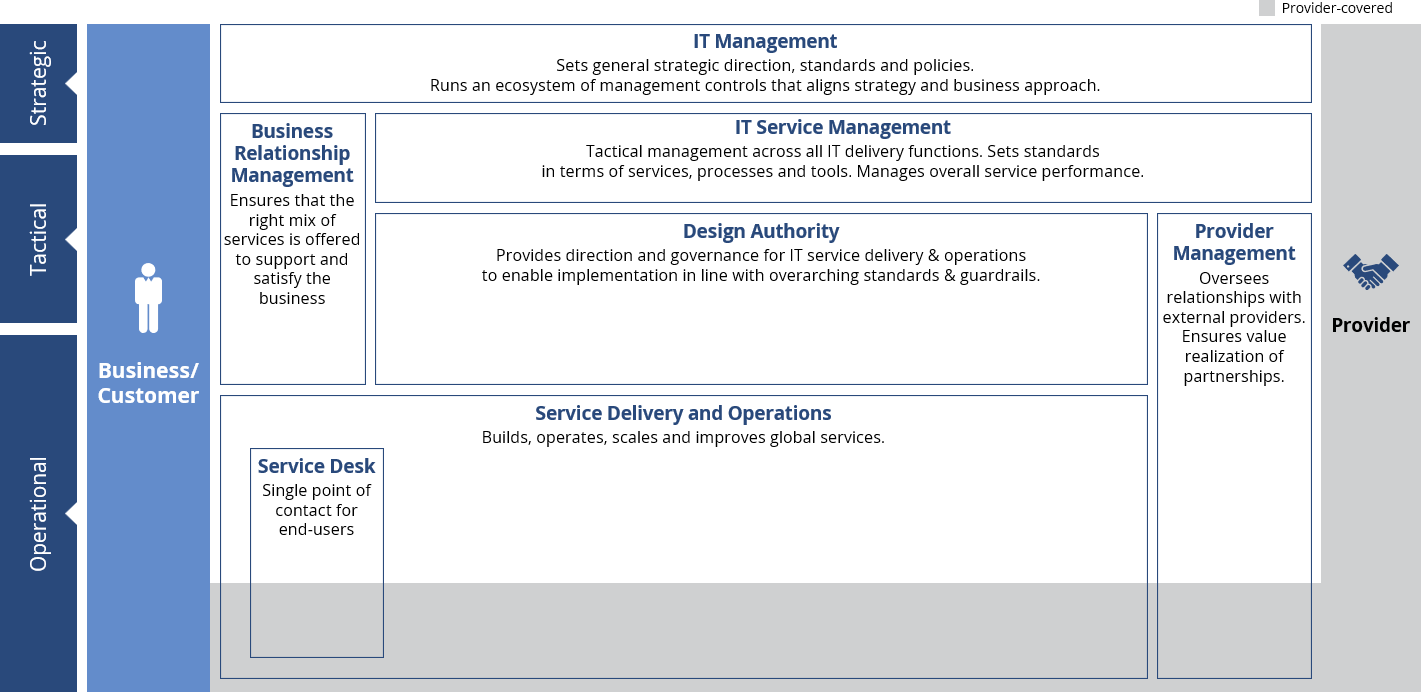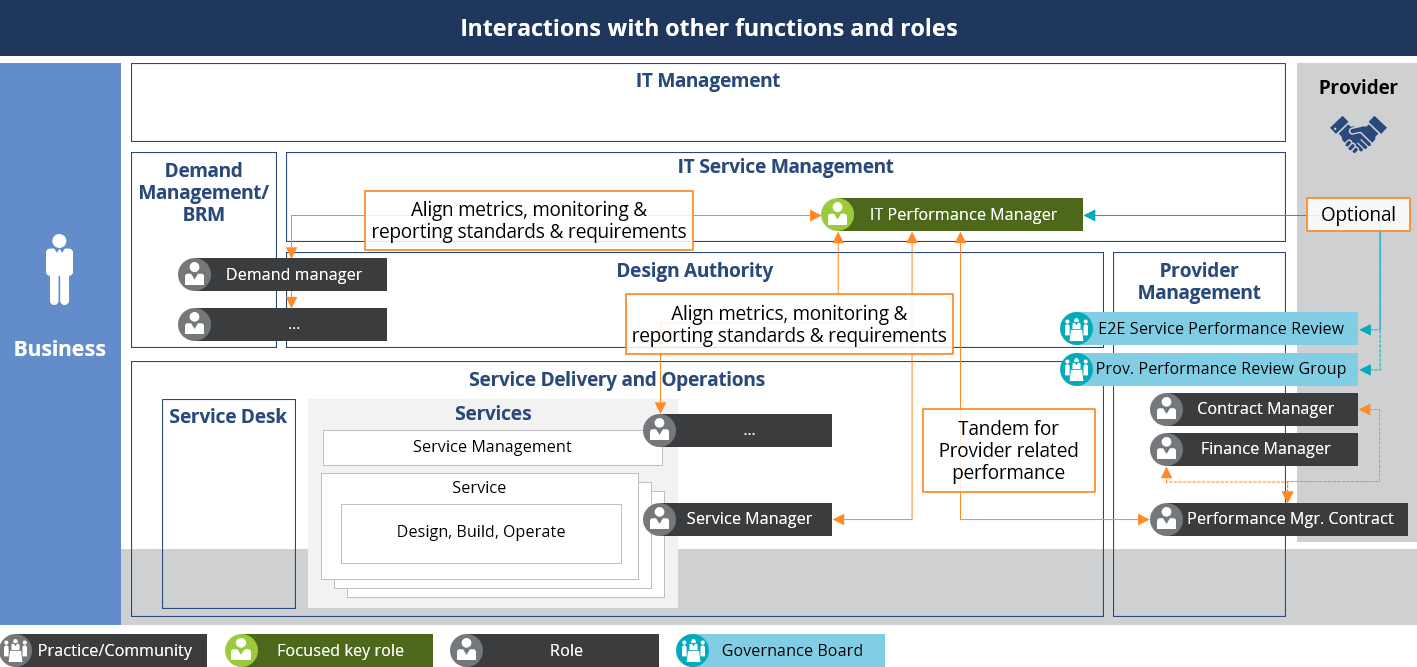How to Set Up an IT Organization to Drive Business Value
The IT Operating Model Framework of the Future lays out a complete framework for defining an IT operating model that meets the needs of the modern enterprise.
When it comes to designing or transforming to a new IT operating model, there is a common misconception about the approach. Many focus primarily on updating the organizational structure and consider it a matter of rearranging names in boxes to match the newly defined line management structures.
But the truth is, enterprises should not start with the organizational chart when it comes to updating their operating model.
Instead, organizations should review, define and design the building blocks of their organization from a functional perspective. This allows you to build your organization around capabilities and value generation instead of people and hierarchies.
Enterprises should approach organizational change by taking a step back, gaining a new perspective and defining a functional model first. The organizational chart will follow.
Typical Situations Leading to Changes in the Organizational Setup
Enterprises are often unsure of the best way to review and ultimately change their organizational setup. The three most common situations that trigger organizational change include ongoing transformative initiatives, lack of transparency and operating model assessment.
Ongoing Initiatives that Trigger Organizational Review or Update
A range of internal or external initiatives can trigger a review of and/or change to the organizational structure, including:Technology transformation initiatives, such as cloud transformations that lead to different delivery models with regard to hosting and backbone services, and software-as-a-service delivery models that lead to a shift in roles required for delivery
New ways of working, e.g. scaled agile that leads to changes in responsibilities and decision-making authority within teams and management
Sourcing, shoring, carve-out or M&A initiatives that lead to changes in responsibilities and sizing of the organization
Lack of Transparency into the Organizational Structure
A change in (senior) leadership can prompt the need to better understand the current organizational setup. This is especially relevant for organizations that evolved over time – growing and changing for years or even decades. While the organizational structure may be well understood by a group of employees and managers, they are difficult to grasp when leadership roles move in and out of the organization.When an Operating Model Assessment Prompts Change
During ISG’s Operating Model Assessment, we often discover a need to review the organizational structure. A high-level review at the early stages of an operating model assessment is beneficial, but immediately trying to implement changes to the organizational structure without prior functional breakdown of the operating model is not recommended.
Common Pitfalls to Successfully Setting Up Your IT Organization
Changes to the organizational structure are often required to drive value generation in IT. But it’s easy to go wrong. Watch out for these common mistakes:
Moving boxes in the org chart without validating their purpose and responsibilities as a result of leadership changes. This can lead to missed opportunities for consolidation and optimization of talent allocation in the organization. Similar outcomes can happen when role and department titles are simply updated and yet the org structure remains unchanged, as is often the case when introducing agile terminology. [ED4] [SW5]
Using an org chart to define functions, roles and responsibilities. Organizational charts are often modeled after business units or regions, depicting them as siloed entities. This bears the risk of not showing dependencies within the organization. For example, teams with cross-functional responsibilities can reach across different areas, but often the org chart fails to reflect these scenarios. These types of “shadow functions” are common in larger organizations, especially after consolidation through M&A.
Building an organization around people instead of roles and keeping responsibilities with existing leadership positions and hierarchies in the organization (sometimes even outside of IT).
Focusing on formal processes instead of outcomes. In our experience, when functional mandates are not clear in process optimization initiatives, enterprises experience a lower success rate for operating model implementation and acceptance.
Please fill out this form to continue.
Using a Functional Model to Get It Right
The pitfalls mentioned above share a commonality: they start with the second step instead of the first. This can be avoided by reviewing and defining the future organization based on a functional model.
A functional model focuses on the capabilities provided by the IT organization and enables a logical structure reflecting those.
A functional model is:
- Universally applicable to any organizational review and organizational design initiative.
- An easy entry point to define priorities and roadmap for organizational review.
- A good way to reduce complexity in the first phase of the organizational review and design through focus on functions. This means that more detailed artifacts can be addressed in later stages of the initiative, e.g. role descriptions, processes or skill matrix.
- Enables the organization to make decisions on the functional org setup without making decisions on the roles and responsibilities of individual people (incl. leadership).
- Guides all phases of organizational change, including change management.
Based on decades of project experience, we have developed a functional model blueprint for IT organizations. Because every organization is different, the blueprint is always adapted to specific needs and targets.
What Are the Components of the Functional Model
To help organizations “bond” with the functional model, it’s smart to start with a handful of high-level and easy-to-grasp function blocks as a “baseline.”
By summarizing logically related functions, these less granular function blocks already indicate a spot on the supply chain between business and provider and its management-level scope, from strategic to operational.
Functional Model Overview

Figure 1: The Functional Model Overview sets the baseline for a more granular functional breakdown.
Figure 1 shows the function blocks that best depict regular and necessary activities that all IT organizations perform in some way:
- IT management, for the strategic layer
- IT service management, for the tactical IT management
- Business relationship management, acting as the interface to the business
- Service delivery and operations, as the IT organization’s heartbeat
- Provider management, covering third parties in IT service provision
We further found that a sixth function block, acting as a link between functions, significantly enhances the value orientation and effectiveness of organizations. We call this sweet spot:
Design authority, providing governance for IT service delivery and operations
Drilling down into function blocks reveals their functions. This is where considerations about business specifics are typically made and some customizations are applied. All functions follow a set objective and outline the necessary contributing activities, without getting into too much “RASCI-level” detail.
Functions Overview

Figure 2: The Functions Overview reveal objectives and categories for each function.
In addition, the function descriptions are enriched by naming associated roles and processes to those functions, as you can see illustrated in Figure 2. Those especially come in handy when operationalizing the functional model.
A role-centric “scope on a page” visualization of responsibilities, interactions or assignments to meetings and governance bodies (see Figure 3: Interaction Charter below) can further boost comprehension of the operating model for management and operational staff alike.
Functional Model Interaction Charter

Figure 3: The Functional Model Interaction Charter provides another level of understanding for the organization.
The Functional Model in the Context of Org Design
Of course, while the functional model is a keytool in org design, it is just one part of the puzzle. Enterprises should follow a top-to-bottom approach for organizational design, starting with a high-level strategy and guiding principles and adding levels of detail as the design takes shape.
Key Components of Organizational Design

Figure 4: Organizational design follows a top-to-bottom approach, starting with high-level materials and then increasing the level of detail.
The Value of an Operating Model Review
Some enterprises don’t want or can’t afford the time it takes to perform a full operating model review. Our 360° Operating Model Workshop is a half- or full-day virtual or onsite workshop that enables a small team to quickly address the most pressing challenges in their operating model and define the way forward. The time invested in this exercise pays back in spades by putting organizations on a path to communications and operations that help them grow and thrive in a changing world.
